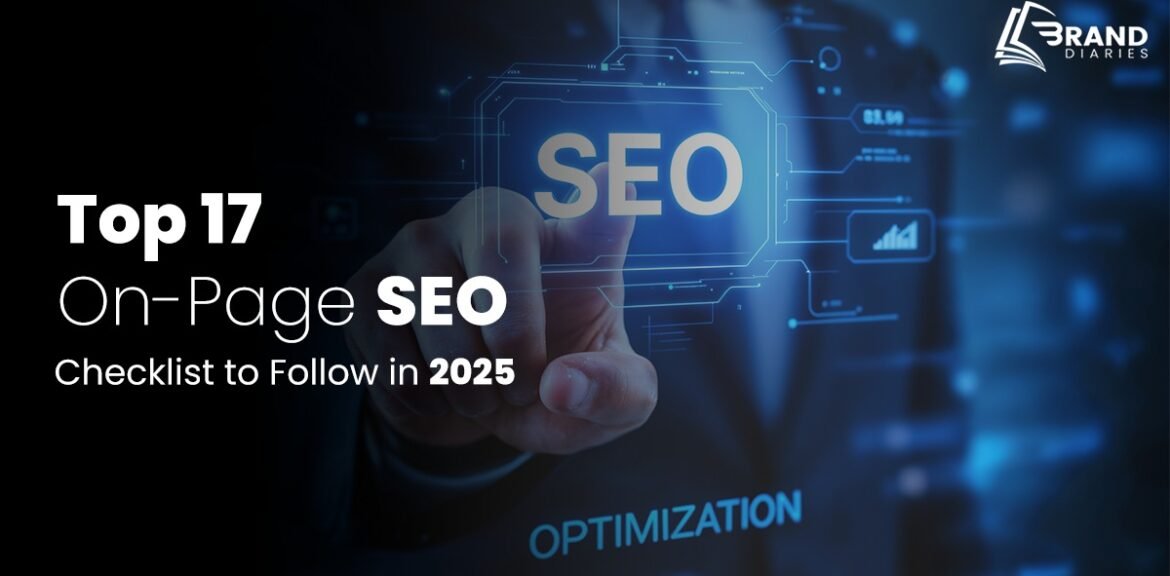The definition of an “optimized” web page has grown increasingly complicated as AI and machine learning continue to impact how search engines evaluate content. By 2025, content intent, semantic relevance, user experience considerations, and structured data signalling will all become important components of on-page SEO. To stay ahead, following a well-structured On Page SEO checklist is essential—it’s now much more than just keyword utilization.
In addition to indexing your content, search engines now analyze experience data, predict intent, and interpret context. In other words, there is less room for error, and accuracy is more important than ever.
This updated on page SEO checklist offers a comprehensive and strategic review of all the crucial elements needed to attain high rankings and consistent organic traffic. This task list will assist you in optimizing editorial material, product pages, or service landing pages.
What does this On-Page SEO Checklist Cover?
This thorough on-page SEO checklist addresses every important optimization area to guarantee that your webpages completely comply with the most recent SEO guidelines. To make implementation easier, we have divided the tasks into four main categories:
- Technical SEO: Ensure your HTML, URLs, and structured data are clean and crawlable.
- Content Optimization: Align content structure, readability, and keyword intent.
- User Experience (UX): Optimize for mobile, page speed, and engagement.
- SEO Enhancers: Use advanced methods like schema, canonical tags, and internal linking.
Read also: Local SEO Checklist for Small Businesses: 10 Essential Steps
17 On-Page SEO Checklist in 2025
Let’s go over each section in detail, emphasizing what needs to be done, why it matters, and how it affects rankings in 2025.
Title Tags
Its purpose is to inform consumers and search engines about the primary topic by acting as the clickable headline in search results.
Items on the checklist:
- Put the main keyword close to the start.
- Don’t go over 50 or 60 characters.
- Make sure every page is distinct.
- Make sure the title and the content match and refrain from cluttering it with keywords.
Best Practice: To increase click-through rates, create titles that are both clear and captivating and integrate user purpose with keyword relevancy.
Meta Descriptions
By providing a summary of the page content, meta descriptions affect click-through rates even though they are not a direct ranking factor.
Items on the checklist:
- 150–160 characters is the limit.
- Naturally incorporate the desired keyword.
- Make certain that each page has a distinct and pertinent description.
- When appropriate, use a gentle call-to-action (CTA).
Best Practice: Write brief descriptions that stand out from the competition and correspond with the user’s search intent.
URL Structure
A clear and legible URL increases user confidence and facilitates better search engine indexing.
Items on the checklist:
- URLs should be brief and keyword-focused.
- When separating words, use hyphens (-).
- Steer clear of stop words, extraneous parameters, and special characters.
- Make sure URLs don’t change often and are static.
Example:
/seo-checklist-2025 (Correct Way)
/seo?id=abc123&type=page (Incorrect Way)
Headings and Content Hierarchy
Headings (H1–H6) serve to define the page’s structure and aid in the comprehension of material flow by both search engines and readers.
Items on the checklist:
- Only one H1 tag—usually the primary headline—should be used per page.
- Subtopics should be arranged logically using H2, H3, etc.
- When appropriate, use both primary and secondary keywords.
- Make sure your heading styles are consistent.
Best Practice: Make sure headings are in line with keyword themes and direct the reader through the material.
Read also: What are the Advantages and Disadvantages of SEO
Content Quality and Optimization
On-page SEO relies heavily on relevant and high-quality content. It must provide value beyond simple keyword targeting and fulfil search intent.
Items on the checklist:
- Answer a particular question or subject in detail.
- To strengthen context, use semantic keywords, often known as LSI terms.
- Include up-to-date information, examples, and reliable sources.
- Steer clear of duplicate information on different pages.
Best Practice: Give creativity, clarity, and depth top priority. Pages should include original ideas that are difficult to find elsewhere.
Keyword Placement
The goal is to improve discoverability while preserving readability and natural language through the strategic use of keywords.
Items on the checklist:
Place the primary keyword in:
- Title tag
- Meta description
- H1 tag
- First 100 words of the content
Use secondary and semantic keywords throughout.
Avoid over-optimization and keyword stuffing.
Best Practice: Determine user language and adjust your optimization using tools like SEMrush or Google Search Console.
Image Optimization
When images are appropriately optimized for speed and relevancy, they improve user engagement and SEO.
Items on the checklist:
- Make use of keywords and descriptive file names (e.g., seo-audit-2025.webp).
- For better accessibility and indexability, add ALT text to each image.
- Reduce file size and loading time by compressing photos.
- Make use of contemporary formats (such Webp) and turn on lazy loading.
Best Practice: Make sure images load quickly on all devices and match them to the content’s purpose.
Internal Linking
The goal of internal links is to improve crawlability, spread page authority, and direct viewers to pertinent content.
Items on the Checklist:
- Incorporate a minimum of two to four internal links into lengthy content.
- Employ descriptive anchor text.
- Provide links to important or valuable pages where appropriate.
- Verify that no links are out-of-date or broken.
Best Practice: Create an organized internal linking structure to lower bounce rates and promote SEO silos.
External Linking
Including links to reliable outside sources can strengthen content relevancy and foster trust.
Items on the checklist:
- Provide a link to reliable, reputable sources (such as scholarly, government, and significant publications).
- Steer clear of linking to poor-quality websites or to too many links.
- When appropriate, use the nofollow tag (paid links, for example).
Best Practice: Cite reputable sources to bolster assertions and enhance apparent authority.
Schema Markup (Structured Data)
Schema serves the dual purposes of improving visibility through rich results and assisting search engines in understanding the material.
Items on the Checklist:
- Make use of the proper schema types, such as article, product, FAQ, and breadcrumb.
- Put the JSON-LD format into practice for improved compatibility.
- Use the Rich Results Test from Google to confirm.
- Adapt the schema to changes in the content.
Best Practice: To increase click-through rates and visibility, apply schema to all types of content where appropriate.
Mobile Optimization
Making sure a mobile experience is responsive and easy to use is crucial when using mobile-first indexing.
Items on the checklist:
- Make use of responsive design frameworks.
- Make sure that on small screens, buttons and calls to action can be tappable.
- Keep enough white space and legible font sizes.
- Steer clear of invasive pop-ups or interstitials.
Best Practice: To guarantee device compatibility, use Google’s Mobile-Friendly Test.
Core Web Vitals and Page Speed

User engagement and rankings are directly impacted by page speed and user experience metrics.
Items on the checklist:
- Largest Contentful Paint (LCP): under 2.5 seconds.
- Interaction to Next Paint (INP): under 200ms.
- Cumulative Layout Shift (CLS): less than 0.1.
- Use CDN, browser caching, and code minification.
Best Practice: To guarantee peak performance, conduct routine audits with Lighthouse and PageSpeed Insights.
User Engagement and Experience
Search performance is impacted by behavioural indicators, including dwell duration, bounce rate, and time on site.
Items on the checklist:
- Make insightful and interesting introductions.
- To keep people’s attention, use multimedia (charts, films, and pictures).
- Throughout the content, include concise and relevant calls to action.
- Cut down on distractions and enhance the clarity of navigation.
Best Practice: Make iterative UX enhancements and monitor engagement numbers using programs like Google Analytics 4.
Regular Content Audits
Consistent optimization, updating, and monitoring are necessary to maintain on-page SEO.
Items on the checklist:
- Check the content for broken links or out-of-date information.
- Update statistics and metadata on a regular basis.
- When necessary, combine overlapping pages.
- Update your XML sitemaps and submit them to Google Search Console.
Best Practice: To make sure your website stays technically solid and competitive, do SEO audits every three months.
Author Information & E-A-T Signals
Google places a strong emphasis on knowledge, authority, and trust in its requirements for YMYL (Your Money or Your Life) pages. Trustworthiness is enhanced by displaying clear author and editorial information.
Items on the checklist:
- At the end of the post, include the author’s name, photo, and brief biography.
- For credibility, include a link to the author’s complete LinkedIn profile.
- Cite reliable sources or include references in the text.
- When appropriate, include the date of the review or update.
Best Practice: Make sure your website uses the same E-A-T framework. To support structured data, create an author schema using Person type markup.
International & Multilingual SEO (hreflang)
Using hreflang guarantees that the appropriate audience sees the appropriate version of your content if your website caters to several languages or geographical areas.
Items on the checklist:
- Use correct hreflang annotations in the <head> or sitemap.
- Match language-country codes accurately (e.g., en-us, fr-fr).
- Avoid duplicate content across language versions.
- Localize — don’t just translate — content, meta tags, and call-to-actions.
Best Practice: Use resources such as Google Search Console’s International Targeting Report, Ahrefs Site Audit, or Screaming Frog to validate hreflang implementation.
SEO Maintenance & Content Audits
On-page SEO is a continuous process. Continuous audits assist in locating problems brought on by updates, broken links, out-of-date information, or changing search intent.
Items on the checklist:
- Conduct content audits every three months, updating out-of-date statistics and eliminating unnecessary parts.
- Utilize Search Console data to reoptimize poorly performing pages.
- Look for picture issues and broken links.
- Test new meta descriptions and keep an eye on CTRs on important pages.
Best Practice: Establish a calendar for regular SEO audits. To find low-performing pages, use technologies like as Google Analytics, Sitebulb, and Screaming Frog.
Final Words
A checklist is only as powerful as its implementation. This complete on-page SEO checklist for 2025 is designed to help you move from scattered optimization to a repeatable, measurable process.
Whether you’re working on a blog, product page, or landing page, start applying these steps immediately. Regular audits, thoughtful updates, and a commitment to SEO hygiene will set your website up for long-term organic success.
The key takeaway? Every detail matters. Start checking those boxes.





